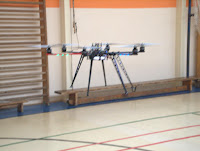 |
| First glimpse in Miroslav's office |
 |
| Doesn't everyone have a 3D milling machine in their office? |
 |
| The smart electronics of the MK |
 |
| Test flight with experienced pilot |
We rented a gymnasium for the test flight, and Miroslav showed me the basic controls for its maiden flight, which verified everything was nicely operating and well-balanced. I wasn't quite ready to take the controls for a full cycle of take-off and landing, but I learned the basics of how to increase thrust and rotate the machine left or right.
I returned to Vienna, and started my training by installing a RC Helicopter flight simulator on an old Windows XP laptop. I immediately learned that the simulator was a great investment. I must have crashed the virtual choppers at least a hundred times, learning the basics of the dual joystick controls.
 |
| My JR DSX11 RC controller |
The simulator controller looks a little different from the RC controller. Its controls also function a little differently too, so I was a little nervous when I finally found the opportunity to take my Hexa out for some actual flight time.
Having never flown any sort of Radio-Control model aircraft before, I was a little nervous about how I would manage the XL. Although it has a reputation as a very stable platform, and despite my dozens of hours on the simulator, I was not looking forward to a possible crash.
Today's weather was overcast, with sporadic rain showers -- again, not ideal for a maiden flight, especially with a slightly gusty wind. After shopping for the week's groceries, it was after 2 p.m. before I headed outside, determined to give it a decent go. It was 3 degrees Celcius, so I didn't want to stay outdoors for too long.
Near my house is an empty field, which during summer is worked for silage crops by one of the local farmers. I set up my video camera on a tripod, and set down the XL onto the ground. I ran a few pre-flight checks, then started the engines. The first few minutes were spent edging closer and closer to lift-off, but each time I noticed the platform was uneven, tipping one way or another, so I eased off on the power.
After adjusting the balance of the empty camera holder mounted underneath, I decided to use the roll and pitch controls to compensate for the apparent instability during takeoff, as well as ensuring that the nose was pointed into the prevailing wind. Somehow, I found the right combination, and had the thrill of my first flight!
As you will see in the linked video, I still have some issues about the height controls. Even though I make tiny adjustments to the throttle, I find that the challenge of maintaining a constant height is not easy, and once or twice I bounced the craft off the ground, before recovering again. I'm trying to fly nose-out, as this is how I trained in the simulator. The Hexa has been set up with brightly colored LEDs to show the nose, but I didn't always keep the correct orientation.
After a few bounces, I realized I could call them "test landings", and when I was ready, guided the bird in for its "official" touch down. Who says kiwis can't fly?


